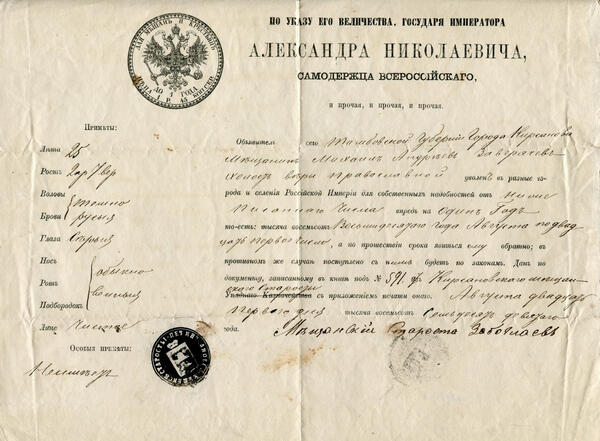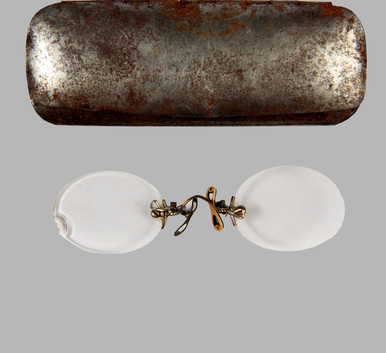Mikhail Andreevich Zaveryachev, the manager of the large Boratynsky estate in Ilyinovka, was often away on business. According to his diary, he regularly traveled to Kirsanov for the fair, to Tambov to pay interest on bills, and to the neighboring estates for household needs. At the end of the 19th century a passport was required for all travel. At various times the documents which allowed movement around the country were called “peasant’s passports”, “roadways letters” and “traveler’s letters”.
Printed passports were introduced in Russia in 1803. The word “passport” was borrowed from the French language. It denoted permission to pass through a port. The law obliged all citizens to show their passports when traveling from one governorate to another at the outposts set up in towns, and to produce them to the police upon arrival at their destination.
From 1833 to the end of the 19th century, the main law stipulating the rights and duties of the police in implementing the passport regime in the Russian Empire was the “Statute on passport holders and fugitives”.
The main provision of the Charter stated that no one was to leave their place of permanent residence without a legitimate document or passport. Noblemen who were not in civil service did not have to hold passports; instead, they were entitled to a certificate of nobility. For peasants and bourgeoisie there were three categories of passports, which were issued depending on the distance a person had to travel from the permanent place of residence and their period of validity (up to three years at the most).
If a person with an expired passport was detained, the police sent them back to their place of registration after placing them under administrative arrest for two or three days. If a detainee did not have a legal residence permit and failed to prove his identity, he was treated as a vagrant. In Russia, vagrancy was treated as a criminal offense and punished by deportation to Siberia (Article 950 of the Penal Code).
The passport on display in the Kirsanov museum was issued to a petty bourgeois of Tambov Governorate, Kirsanov District, Mikhail Andreevich Zaveryachev in 1879 for a period of one year. This passport reveals the age of Mikhail Zaveryachev at that time — 25 years, marital status — single, his features: height — 2 arshin 7 inches (173 cm), gray eyes, dark brown hair. The passport is signed by the petty bourgeois headman Zabozlaev. The photo of M. A. Zaveryachev is also housed in the Kirsanov Local History Museum.
Printed passports were introduced in Russia in 1803. The word “passport” was borrowed from the French language. It denoted permission to pass through a port. The law obliged all citizens to show their passports when traveling from one governorate to another at the outposts set up in towns, and to produce them to the police upon arrival at their destination.
From 1833 to the end of the 19th century, the main law stipulating the rights and duties of the police in implementing the passport regime in the Russian Empire was the “Statute on passport holders and fugitives”.
The main provision of the Charter stated that no one was to leave their place of permanent residence without a legitimate document or passport. Noblemen who were not in civil service did not have to hold passports; instead, they were entitled to a certificate of nobility. For peasants and bourgeoisie there were three categories of passports, which were issued depending on the distance a person had to travel from the permanent place of residence and their period of validity (up to three years at the most).
If a person with an expired passport was detained, the police sent them back to their place of registration after placing them under administrative arrest for two or three days. If a detainee did not have a legal residence permit and failed to prove his identity, he was treated as a vagrant. In Russia, vagrancy was treated as a criminal offense and punished by deportation to Siberia (Article 950 of the Penal Code).
The passport on display in the Kirsanov museum was issued to a petty bourgeois of Tambov Governorate, Kirsanov District, Mikhail Andreevich Zaveryachev in 1879 for a period of one year. This passport reveals the age of Mikhail Zaveryachev at that time — 25 years, marital status — single, his features: height — 2 arshin 7 inches (173 cm), gray eyes, dark brown hair. The passport is signed by the petty bourgeois headman Zabozlaev. The photo of M. A. Zaveryachev is also housed in the Kirsanov Local History Museum.



